Comprehensive Nursing Case Study: Breast Cancer Care Plan
VerifiedAdded on 2022/08/20
|8
|2569
|29
Case Study
AI Summary
This case study presents a comprehensive nursing care plan for Amy, a patient diagnosed with breast cancer and undergoing chemotherapy. The assignment identifies the increased risk of infection as a primary health need, stemming from the immunosuppressive effects of chemotherapy. The care plan utilizes the Socioecological framework to address this risk, incorporating the Corbin and Strauss Illness Trajectory Model for assessment. It explores the patient's personal circumstances, including her recent relocation, dietary habits, and close relationships, as well as organizational and community support systems. The plan emphasizes the importance of hygiene, nutritional guidance, and access to community resources like support groups. The case study highlights the crucial role of nurses in providing education, emotional support, and coordinating care to mitigate infection risks and improve the patient's overall well-being during treatment. It also stresses the need for organizational support, and the utilization of equipment and services such as hand hygiene, dieticians, and protective equipment to reduce the risk of infection.

Running head: NURSING CASE STUDY
A CARE PLAN FOR A PATIENT SUFFERING FROM BREAST CANCER
Name of the Student:
Name of the University:
Author’s Note:
A CARE PLAN FOR A PATIENT SUFFERING FROM BREAST CANCER
Name of the Student:
Name of the University:
Author’s Note:
Paraphrase This Document
Need a fresh take? Get an instant paraphrase of this document with our AI Paraphraser
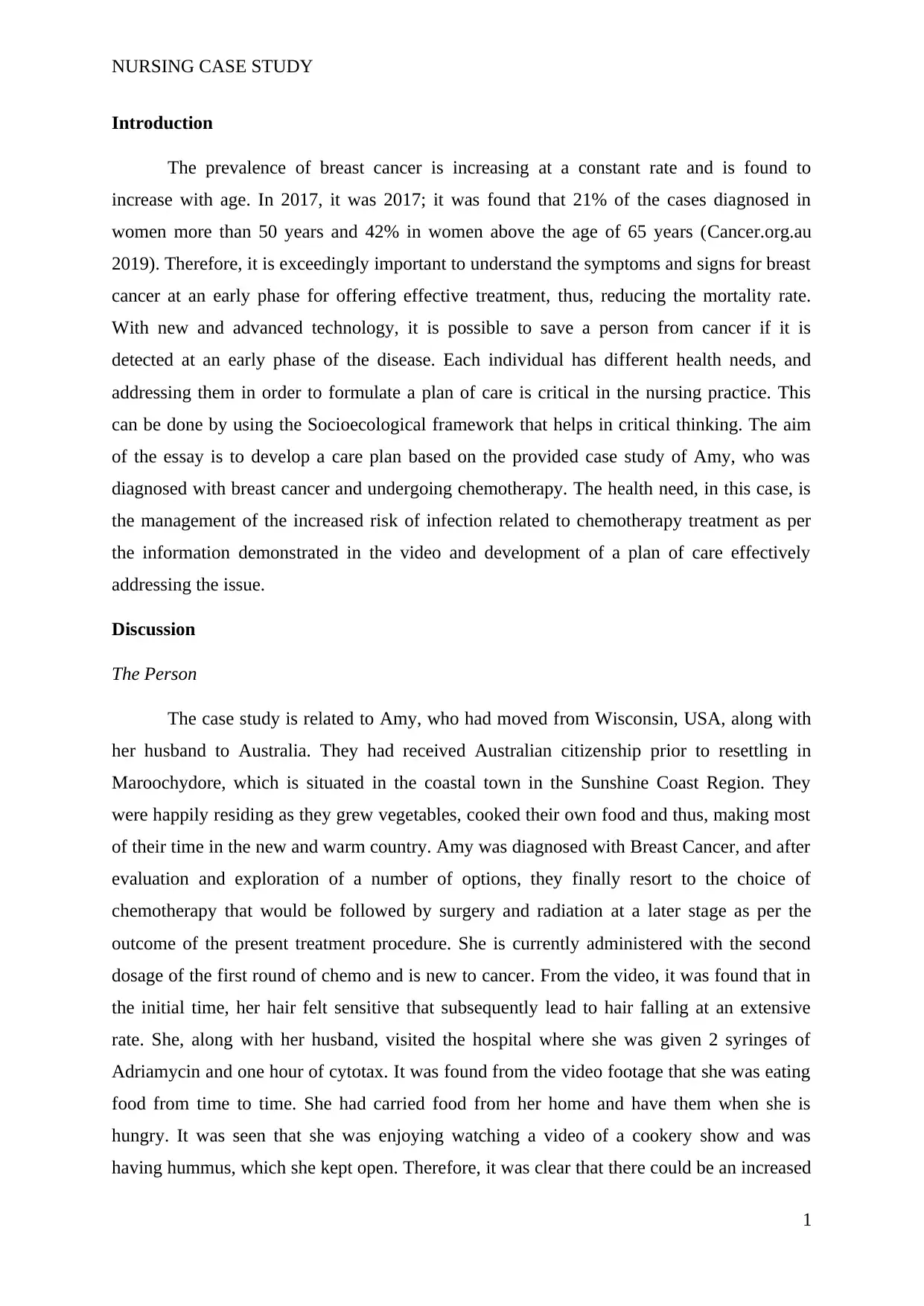
NURSING CASE STUDY
Introduction
The prevalence of breast cancer is increasing at a constant rate and is found to
increase with age. In 2017, it was 2017; it was found that 21% of the cases diagnosed in
women more than 50 years and 42% in women above the age of 65 years (Cancer.org.au
2019). Therefore, it is exceedingly important to understand the symptoms and signs for breast
cancer at an early phase for offering effective treatment, thus, reducing the mortality rate.
With new and advanced technology, it is possible to save a person from cancer if it is
detected at an early phase of the disease. Each individual has different health needs, and
addressing them in order to formulate a plan of care is critical in the nursing practice. This
can be done by using the Socioecological framework that helps in critical thinking. The aim
of the essay is to develop a care plan based on the provided case study of Amy, who was
diagnosed with breast cancer and undergoing chemotherapy. The health need, in this case, is
the management of the increased risk of infection related to chemotherapy treatment as per
the information demonstrated in the video and development of a plan of care effectively
addressing the issue.
Discussion
The Person
The case study is related to Amy, who had moved from Wisconsin, USA, along with
her husband to Australia. They had received Australian citizenship prior to resettling in
Maroochydore, which is situated in the coastal town in the Sunshine Coast Region. They
were happily residing as they grew vegetables, cooked their own food and thus, making most
of their time in the new and warm country. Amy was diagnosed with Breast Cancer, and after
evaluation and exploration of a number of options, they finally resort to the choice of
chemotherapy that would be followed by surgery and radiation at a later stage as per the
outcome of the present treatment procedure. She is currently administered with the second
dosage of the first round of chemo and is new to cancer. From the video, it was found that in
the initial time, her hair felt sensitive that subsequently lead to hair falling at an extensive
rate. She, along with her husband, visited the hospital where she was given 2 syringes of
Adriamycin and one hour of cytotax. It was found from the video footage that she was eating
food from time to time. She had carried food from her home and have them when she is
hungry. It was seen that she was enjoying watching a video of a cookery show and was
having hummus, which she kept open. Therefore, it was clear that there could be an increased
1
Introduction
The prevalence of breast cancer is increasing at a constant rate and is found to
increase with age. In 2017, it was 2017; it was found that 21% of the cases diagnosed in
women more than 50 years and 42% in women above the age of 65 years (Cancer.org.au
2019). Therefore, it is exceedingly important to understand the symptoms and signs for breast
cancer at an early phase for offering effective treatment, thus, reducing the mortality rate.
With new and advanced technology, it is possible to save a person from cancer if it is
detected at an early phase of the disease. Each individual has different health needs, and
addressing them in order to formulate a plan of care is critical in the nursing practice. This
can be done by using the Socioecological framework that helps in critical thinking. The aim
of the essay is to develop a care plan based on the provided case study of Amy, who was
diagnosed with breast cancer and undergoing chemotherapy. The health need, in this case, is
the management of the increased risk of infection related to chemotherapy treatment as per
the information demonstrated in the video and development of a plan of care effectively
addressing the issue.
Discussion
The Person
The case study is related to Amy, who had moved from Wisconsin, USA, along with
her husband to Australia. They had received Australian citizenship prior to resettling in
Maroochydore, which is situated in the coastal town in the Sunshine Coast Region. They
were happily residing as they grew vegetables, cooked their own food and thus, making most
of their time in the new and warm country. Amy was diagnosed with Breast Cancer, and after
evaluation and exploration of a number of options, they finally resort to the choice of
chemotherapy that would be followed by surgery and radiation at a later stage as per the
outcome of the present treatment procedure. She is currently administered with the second
dosage of the first round of chemo and is new to cancer. From the video, it was found that in
the initial time, her hair felt sensitive that subsequently lead to hair falling at an extensive
rate. She, along with her husband, visited the hospital where she was given 2 syringes of
Adriamycin and one hour of cytotax. It was found from the video footage that she was eating
food from time to time. She had carried food from her home and have them when she is
hungry. It was seen that she was enjoying watching a video of a cookery show and was
having hummus, which she kept open. Therefore, it was clear that there could be an increased
1
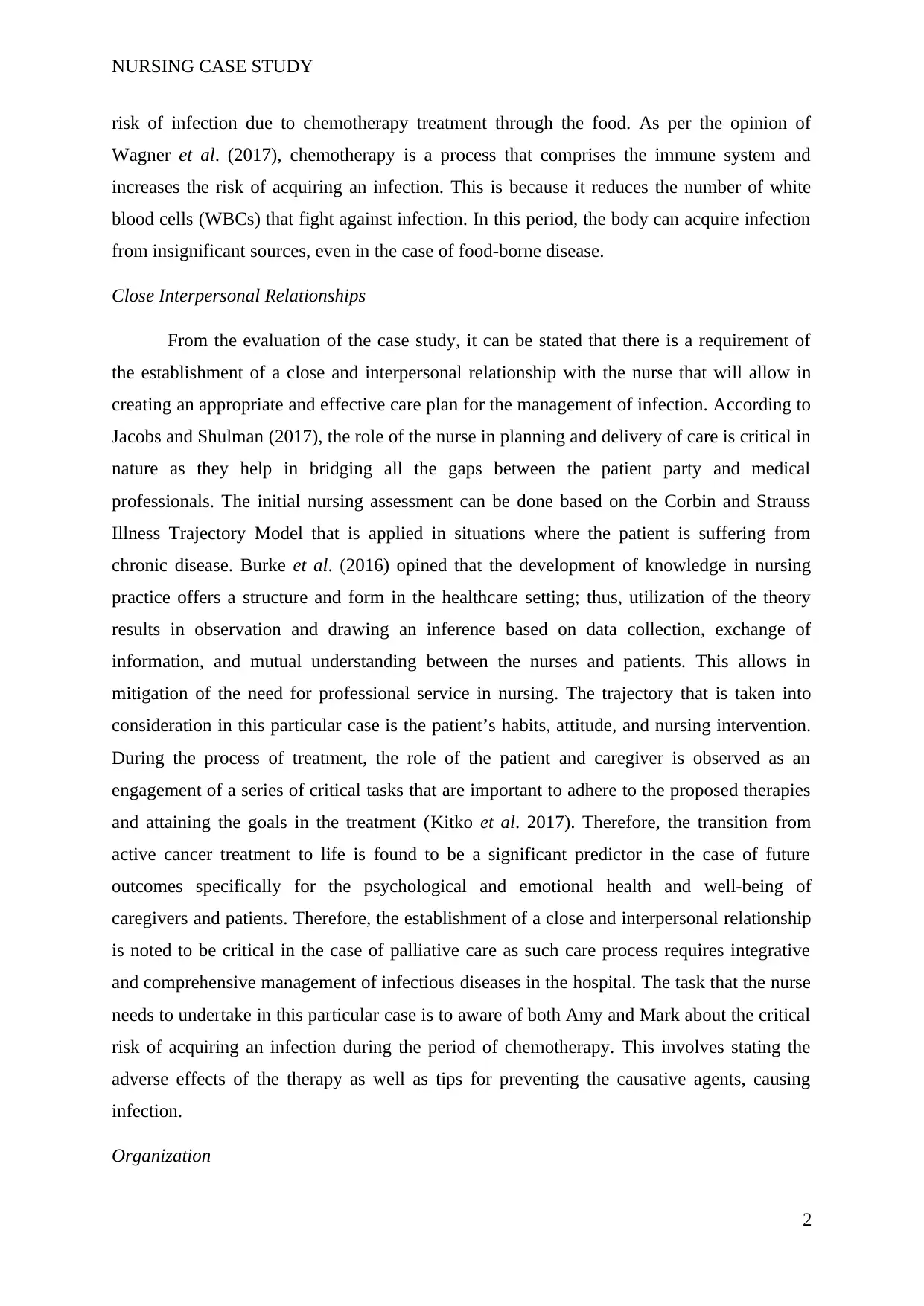
NURSING CASE STUDY
risk of infection due to chemotherapy treatment through the food. As per the opinion of
Wagner et al. (2017), chemotherapy is a process that comprises the immune system and
increases the risk of acquiring an infection. This is because it reduces the number of white
blood cells (WBCs) that fight against infection. In this period, the body can acquire infection
from insignificant sources, even in the case of food-borne disease.
Close Interpersonal Relationships
From the evaluation of the case study, it can be stated that there is a requirement of
the establishment of a close and interpersonal relationship with the nurse that will allow in
creating an appropriate and effective care plan for the management of infection. According to
Jacobs and Shulman (2017), the role of the nurse in planning and delivery of care is critical in
nature as they help in bridging all the gaps between the patient party and medical
professionals. The initial nursing assessment can be done based on the Corbin and Strauss
Illness Trajectory Model that is applied in situations where the patient is suffering from
chronic disease. Burke et al. (2016) opined that the development of knowledge in nursing
practice offers a structure and form in the healthcare setting; thus, utilization of the theory
results in observation and drawing an inference based on data collection, exchange of
information, and mutual understanding between the nurses and patients. This allows in
mitigation of the need for professional service in nursing. The trajectory that is taken into
consideration in this particular case is the patient’s habits, attitude, and nursing intervention.
During the process of treatment, the role of the patient and caregiver is observed as an
engagement of a series of critical tasks that are important to adhere to the proposed therapies
and attaining the goals in the treatment (Kitko et al. 2017). Therefore, the transition from
active cancer treatment to life is found to be a significant predictor in the case of future
outcomes specifically for the psychological and emotional health and well-being of
caregivers and patients. Therefore, the establishment of a close and interpersonal relationship
is noted to be critical in the case of palliative care as such care process requires integrative
and comprehensive management of infectious diseases in the hospital. The task that the nurse
needs to undertake in this particular case is to aware of both Amy and Mark about the critical
risk of acquiring an infection during the period of chemotherapy. This involves stating the
adverse effects of the therapy as well as tips for preventing the causative agents, causing
infection.
Organization
2
risk of infection due to chemotherapy treatment through the food. As per the opinion of
Wagner et al. (2017), chemotherapy is a process that comprises the immune system and
increases the risk of acquiring an infection. This is because it reduces the number of white
blood cells (WBCs) that fight against infection. In this period, the body can acquire infection
from insignificant sources, even in the case of food-borne disease.
Close Interpersonal Relationships
From the evaluation of the case study, it can be stated that there is a requirement of
the establishment of a close and interpersonal relationship with the nurse that will allow in
creating an appropriate and effective care plan for the management of infection. According to
Jacobs and Shulman (2017), the role of the nurse in planning and delivery of care is critical in
nature as they help in bridging all the gaps between the patient party and medical
professionals. The initial nursing assessment can be done based on the Corbin and Strauss
Illness Trajectory Model that is applied in situations where the patient is suffering from
chronic disease. Burke et al. (2016) opined that the development of knowledge in nursing
practice offers a structure and form in the healthcare setting; thus, utilization of the theory
results in observation and drawing an inference based on data collection, exchange of
information, and mutual understanding between the nurses and patients. This allows in
mitigation of the need for professional service in nursing. The trajectory that is taken into
consideration in this particular case is the patient’s habits, attitude, and nursing intervention.
During the process of treatment, the role of the patient and caregiver is observed as an
engagement of a series of critical tasks that are important to adhere to the proposed therapies
and attaining the goals in the treatment (Kitko et al. 2017). Therefore, the transition from
active cancer treatment to life is found to be a significant predictor in the case of future
outcomes specifically for the psychological and emotional health and well-being of
caregivers and patients. Therefore, the establishment of a close and interpersonal relationship
is noted to be critical in the case of palliative care as such care process requires integrative
and comprehensive management of infectious diseases in the hospital. The task that the nurse
needs to undertake in this particular case is to aware of both Amy and Mark about the critical
risk of acquiring an infection during the period of chemotherapy. This involves stating the
adverse effects of the therapy as well as tips for preventing the causative agents, causing
infection.
Organization
2
⊘ This is a preview!⊘
Do you want full access?
Subscribe today to unlock all pages.

Trusted by 1+ million students worldwide
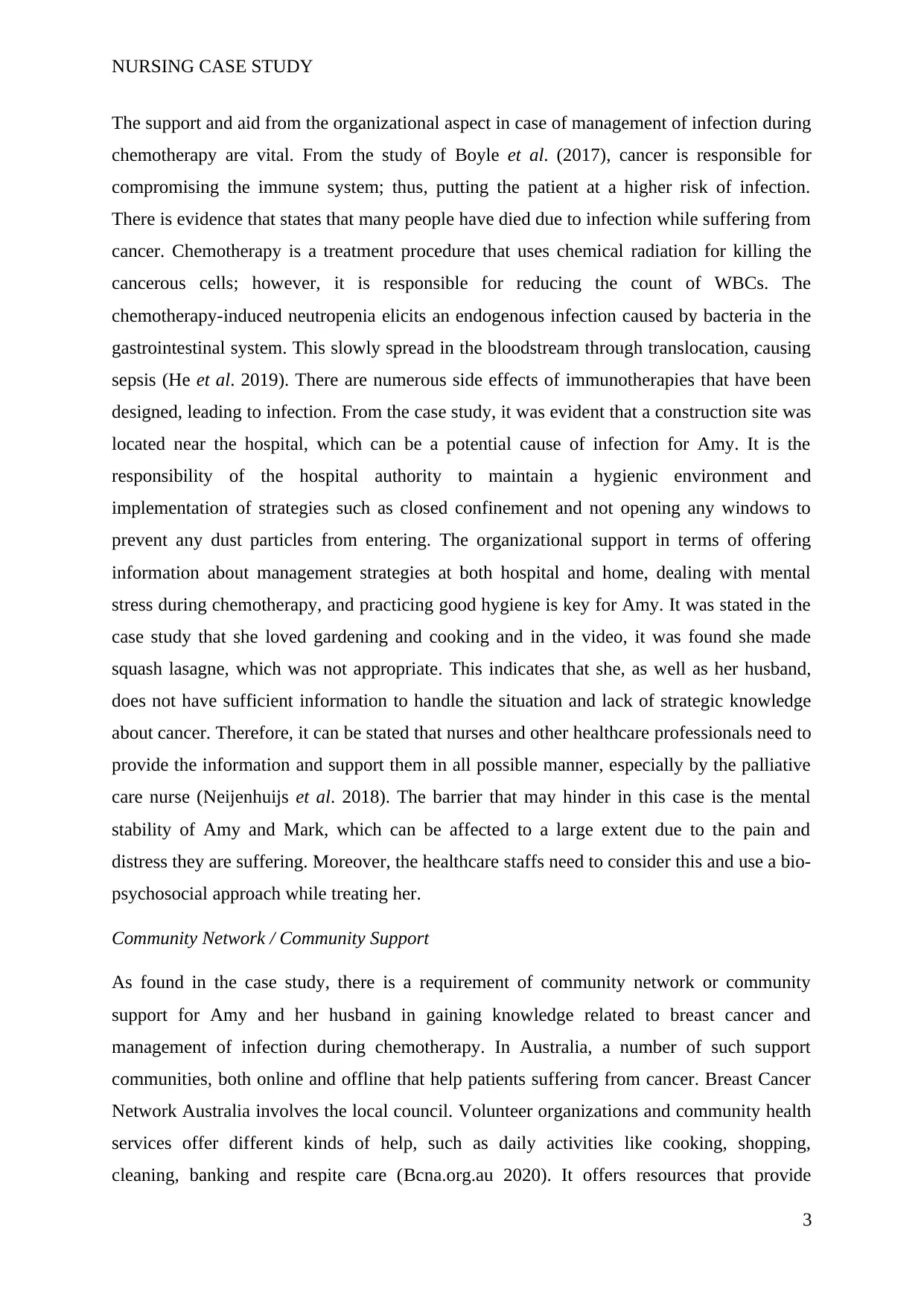
NURSING CASE STUDY
The support and aid from the organizational aspect in case of management of infection during
chemotherapy are vital. From the study of Boyle et al. (2017), cancer is responsible for
compromising the immune system; thus, putting the patient at a higher risk of infection.
There is evidence that states that many people have died due to infection while suffering from
cancer. Chemotherapy is a treatment procedure that uses chemical radiation for killing the
cancerous cells; however, it is responsible for reducing the count of WBCs. The
chemotherapy-induced neutropenia elicits an endogenous infection caused by bacteria in the
gastrointestinal system. This slowly spread in the bloodstream through translocation, causing
sepsis (He et al. 2019). There are numerous side effects of immunotherapies that have been
designed, leading to infection. From the case study, it was evident that a construction site was
located near the hospital, which can be a potential cause of infection for Amy. It is the
responsibility of the hospital authority to maintain a hygienic environment and
implementation of strategies such as closed confinement and not opening any windows to
prevent any dust particles from entering. The organizational support in terms of offering
information about management strategies at both hospital and home, dealing with mental
stress during chemotherapy, and practicing good hygiene is key for Amy. It was stated in the
case study that she loved gardening and cooking and in the video, it was found she made
squash lasagne, which was not appropriate. This indicates that she, as well as her husband,
does not have sufficient information to handle the situation and lack of strategic knowledge
about cancer. Therefore, it can be stated that nurses and other healthcare professionals need to
provide the information and support them in all possible manner, especially by the palliative
care nurse (Neijenhuijs et al. 2018). The barrier that may hinder in this case is the mental
stability of Amy and Mark, which can be affected to a large extent due to the pain and
distress they are suffering. Moreover, the healthcare staffs need to consider this and use a bio-
psychosocial approach while treating her.
Community Network / Community Support
As found in the case study, there is a requirement of community network or community
support for Amy and her husband in gaining knowledge related to breast cancer and
management of infection during chemotherapy. In Australia, a number of such support
communities, both online and offline that help patients suffering from cancer. Breast Cancer
Network Australia involves the local council. Volunteer organizations and community health
services offer different kinds of help, such as daily activities like cooking, shopping,
cleaning, banking and respite care (Bcna.org.au 2020). It offers resources that provide
3
The support and aid from the organizational aspect in case of management of infection during
chemotherapy are vital. From the study of Boyle et al. (2017), cancer is responsible for
compromising the immune system; thus, putting the patient at a higher risk of infection.
There is evidence that states that many people have died due to infection while suffering from
cancer. Chemotherapy is a treatment procedure that uses chemical radiation for killing the
cancerous cells; however, it is responsible for reducing the count of WBCs. The
chemotherapy-induced neutropenia elicits an endogenous infection caused by bacteria in the
gastrointestinal system. This slowly spread in the bloodstream through translocation, causing
sepsis (He et al. 2019). There are numerous side effects of immunotherapies that have been
designed, leading to infection. From the case study, it was evident that a construction site was
located near the hospital, which can be a potential cause of infection for Amy. It is the
responsibility of the hospital authority to maintain a hygienic environment and
implementation of strategies such as closed confinement and not opening any windows to
prevent any dust particles from entering. The organizational support in terms of offering
information about management strategies at both hospital and home, dealing with mental
stress during chemotherapy, and practicing good hygiene is key for Amy. It was stated in the
case study that she loved gardening and cooking and in the video, it was found she made
squash lasagne, which was not appropriate. This indicates that she, as well as her husband,
does not have sufficient information to handle the situation and lack of strategic knowledge
about cancer. Therefore, it can be stated that nurses and other healthcare professionals need to
provide the information and support them in all possible manner, especially by the palliative
care nurse (Neijenhuijs et al. 2018). The barrier that may hinder in this case is the mental
stability of Amy and Mark, which can be affected to a large extent due to the pain and
distress they are suffering. Moreover, the healthcare staffs need to consider this and use a bio-
psychosocial approach while treating her.
Community Network / Community Support
As found in the case study, there is a requirement of community network or community
support for Amy and her husband in gaining knowledge related to breast cancer and
management of infection during chemotherapy. In Australia, a number of such support
communities, both online and offline that help patients suffering from cancer. Breast Cancer
Network Australia involves the local council. Volunteer organizations and community health
services offer different kinds of help, such as daily activities like cooking, shopping,
cleaning, banking and respite care (Bcna.org.au 2020). It offers resources that provide
3
Paraphrase This Document
Need a fresh take? Get an instant paraphrase of this document with our AI Paraphraser
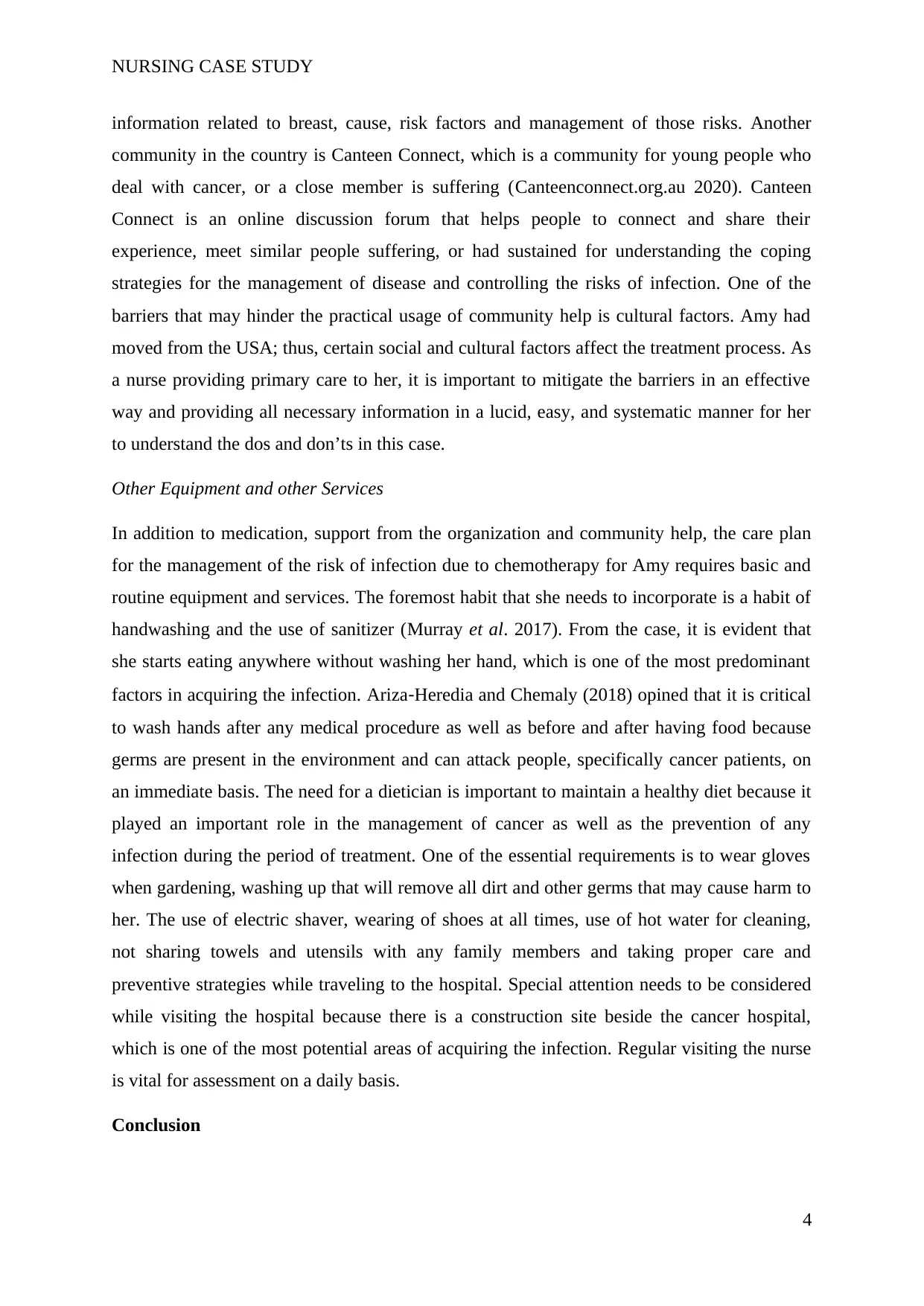
NURSING CASE STUDY
information related to breast, cause, risk factors and management of those risks. Another
community in the country is Canteen Connect, which is a community for young people who
deal with cancer, or a close member is suffering (Canteenconnect.org.au 2020). Canteen
Connect is an online discussion forum that helps people to connect and share their
experience, meet similar people suffering, or had sustained for understanding the coping
strategies for the management of disease and controlling the risks of infection. One of the
barriers that may hinder the practical usage of community help is cultural factors. Amy had
moved from the USA; thus, certain social and cultural factors affect the treatment process. As
a nurse providing primary care to her, it is important to mitigate the barriers in an effective
way and providing all necessary information in a lucid, easy, and systematic manner for her
to understand the dos and don’ts in this case.
Other Equipment and other Services
In addition to medication, support from the organization and community help, the care plan
for the management of the risk of infection due to chemotherapy for Amy requires basic and
routine equipment and services. The foremost habit that she needs to incorporate is a habit of
handwashing and the use of sanitizer (Murray et al. 2017). From the case, it is evident that
she starts eating anywhere without washing her hand, which is one of the most predominant
factors in acquiring the infection. Ariza‐Heredia and Chemaly (2018) opined that it is critical
to wash hands after any medical procedure as well as before and after having food because
germs are present in the environment and can attack people, specifically cancer patients, on
an immediate basis. The need for a dietician is important to maintain a healthy diet because it
played an important role in the management of cancer as well as the prevention of any
infection during the period of treatment. One of the essential requirements is to wear gloves
when gardening, washing up that will remove all dirt and other germs that may cause harm to
her. The use of electric shaver, wearing of shoes at all times, use of hot water for cleaning,
not sharing towels and utensils with any family members and taking proper care and
preventive strategies while traveling to the hospital. Special attention needs to be considered
while visiting the hospital because there is a construction site beside the cancer hospital,
which is one of the most potential areas of acquiring the infection. Regular visiting the nurse
is vital for assessment on a daily basis.
Conclusion
4
information related to breast, cause, risk factors and management of those risks. Another
community in the country is Canteen Connect, which is a community for young people who
deal with cancer, or a close member is suffering (Canteenconnect.org.au 2020). Canteen
Connect is an online discussion forum that helps people to connect and share their
experience, meet similar people suffering, or had sustained for understanding the coping
strategies for the management of disease and controlling the risks of infection. One of the
barriers that may hinder the practical usage of community help is cultural factors. Amy had
moved from the USA; thus, certain social and cultural factors affect the treatment process. As
a nurse providing primary care to her, it is important to mitigate the barriers in an effective
way and providing all necessary information in a lucid, easy, and systematic manner for her
to understand the dos and don’ts in this case.
Other Equipment and other Services
In addition to medication, support from the organization and community help, the care plan
for the management of the risk of infection due to chemotherapy for Amy requires basic and
routine equipment and services. The foremost habit that she needs to incorporate is a habit of
handwashing and the use of sanitizer (Murray et al. 2017). From the case, it is evident that
she starts eating anywhere without washing her hand, which is one of the most predominant
factors in acquiring the infection. Ariza‐Heredia and Chemaly (2018) opined that it is critical
to wash hands after any medical procedure as well as before and after having food because
germs are present in the environment and can attack people, specifically cancer patients, on
an immediate basis. The need for a dietician is important to maintain a healthy diet because it
played an important role in the management of cancer as well as the prevention of any
infection during the period of treatment. One of the essential requirements is to wear gloves
when gardening, washing up that will remove all dirt and other germs that may cause harm to
her. The use of electric shaver, wearing of shoes at all times, use of hot water for cleaning,
not sharing towels and utensils with any family members and taking proper care and
preventive strategies while traveling to the hospital. Special attention needs to be considered
while visiting the hospital because there is a construction site beside the cancer hospital,
which is one of the most potential areas of acquiring the infection. Regular visiting the nurse
is vital for assessment on a daily basis.
Conclusion
4

NURSING CASE STUDY
From the essay, it can be concluded that Amy, a patient who has breast cancer who is
least concerned about acquiring infection at the time of chemotherapy. Therefore, a care plan
is formulated based on the complex need of the patient by including the entire surrounding
environment with respect to the socio-ecological framework is to develop knowledge and the
provision of clinical decision-making in order to offer both physical and mental support to
Amy and her husband in an appropriate manner.
5
From the essay, it can be concluded that Amy, a patient who has breast cancer who is
least concerned about acquiring infection at the time of chemotherapy. Therefore, a care plan
is formulated based on the complex need of the patient by including the entire surrounding
environment with respect to the socio-ecological framework is to develop knowledge and the
provision of clinical decision-making in order to offer both physical and mental support to
Amy and her husband in an appropriate manner.
5
⊘ This is a preview!⊘
Do you want full access?
Subscribe today to unlock all pages.

Trusted by 1+ million students worldwide
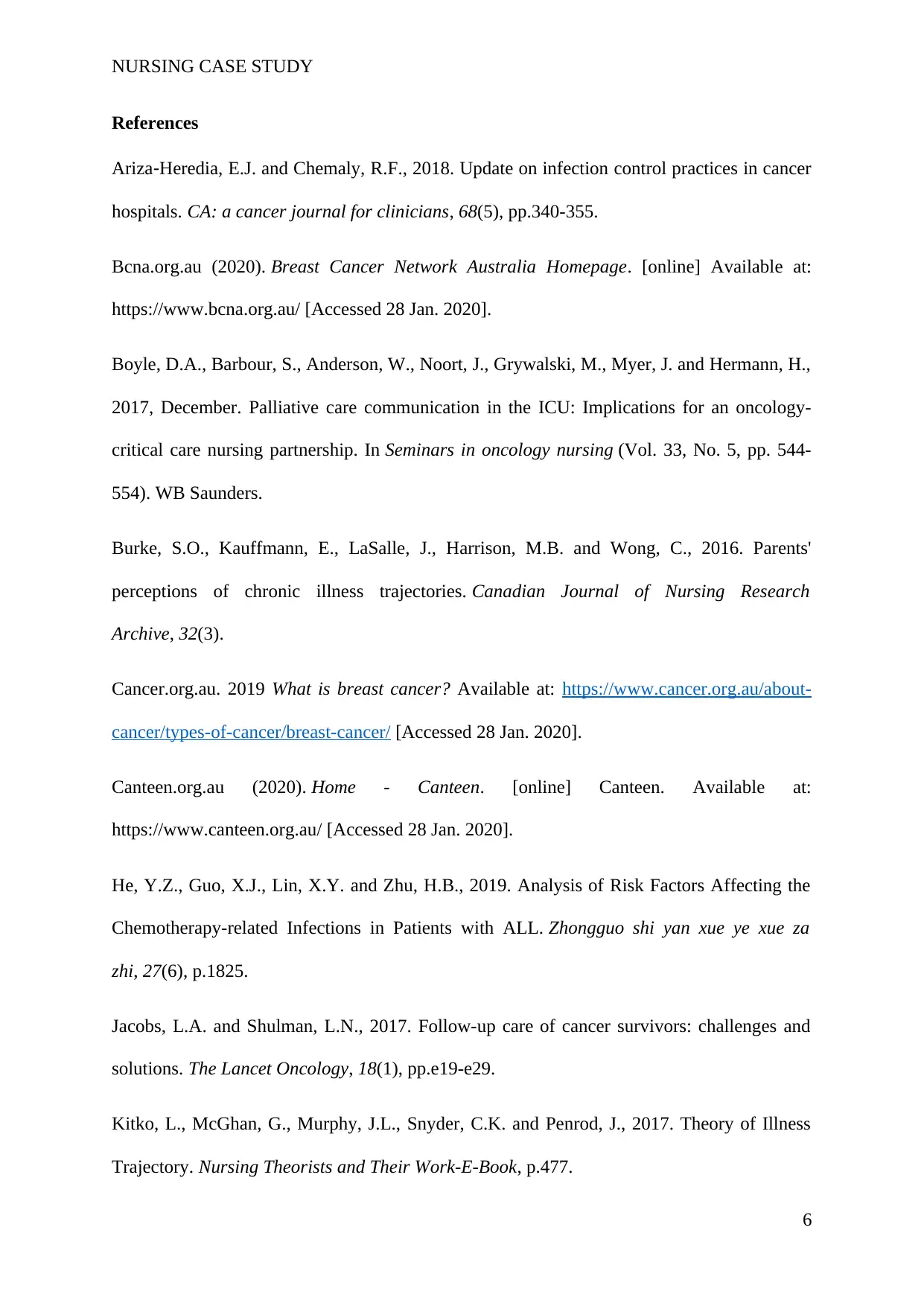
NURSING CASE STUDY
References
Ariza‐Heredia, E.J. and Chemaly, R.F., 2018. Update on infection control practices in cancer
hospitals. CA: a cancer journal for clinicians, 68(5), pp.340-355.
Bcna.org.au (2020). Breast Cancer Network Australia Homepage. [online] Available at:
https://www.bcna.org.au/ [Accessed 28 Jan. 2020].
Boyle, D.A., Barbour, S., Anderson, W., Noort, J., Grywalski, M., Myer, J. and Hermann, H.,
2017, December. Palliative care communication in the ICU: Implications for an oncology-
critical care nursing partnership. In Seminars in oncology nursing (Vol. 33, No. 5, pp. 544-
554). WB Saunders.
Burke, S.O., Kauffmann, E., LaSalle, J., Harrison, M.B. and Wong, C., 2016. Parents'
perceptions of chronic illness trajectories. Canadian Journal of Nursing Research
Archive, 32(3).
Cancer.org.au. 2019 What is breast cancer? Available at: https://www.cancer.org.au/about-
cancer/types-of-cancer/breast-cancer/ [Accessed 28 Jan. 2020].
Canteen.org.au (2020). Home - Canteen. [online] Canteen. Available at:
https://www.canteen.org.au/ [Accessed 28 Jan. 2020].
He, Y.Z., Guo, X.J., Lin, X.Y. and Zhu, H.B., 2019. Analysis of Risk Factors Affecting the
Chemotherapy-related Infections in Patients with ALL. Zhongguo shi yan xue ye xue za
zhi, 27(6), p.1825.
Jacobs, L.A. and Shulman, L.N., 2017. Follow-up care of cancer survivors: challenges and
solutions. The Lancet Oncology, 18(1), pp.e19-e29.
Kitko, L., McGhan, G., Murphy, J.L., Snyder, C.K. and Penrod, J., 2017. Theory of Illness
Trajectory. Nursing Theorists and Their Work-E-Book, p.477.
6
References
Ariza‐Heredia, E.J. and Chemaly, R.F., 2018. Update on infection control practices in cancer
hospitals. CA: a cancer journal for clinicians, 68(5), pp.340-355.
Bcna.org.au (2020). Breast Cancer Network Australia Homepage. [online] Available at:
https://www.bcna.org.au/ [Accessed 28 Jan. 2020].
Boyle, D.A., Barbour, S., Anderson, W., Noort, J., Grywalski, M., Myer, J. and Hermann, H.,
2017, December. Palliative care communication in the ICU: Implications for an oncology-
critical care nursing partnership. In Seminars in oncology nursing (Vol. 33, No. 5, pp. 544-
554). WB Saunders.
Burke, S.O., Kauffmann, E., LaSalle, J., Harrison, M.B. and Wong, C., 2016. Parents'
perceptions of chronic illness trajectories. Canadian Journal of Nursing Research
Archive, 32(3).
Cancer.org.au. 2019 What is breast cancer? Available at: https://www.cancer.org.au/about-
cancer/types-of-cancer/breast-cancer/ [Accessed 28 Jan. 2020].
Canteen.org.au (2020). Home - Canteen. [online] Canteen. Available at:
https://www.canteen.org.au/ [Accessed 28 Jan. 2020].
He, Y.Z., Guo, X.J., Lin, X.Y. and Zhu, H.B., 2019. Analysis of Risk Factors Affecting the
Chemotherapy-related Infections in Patients with ALL. Zhongguo shi yan xue ye xue za
zhi, 27(6), p.1825.
Jacobs, L.A. and Shulman, L.N., 2017. Follow-up care of cancer survivors: challenges and
solutions. The Lancet Oncology, 18(1), pp.e19-e29.
Kitko, L., McGhan, G., Murphy, J.L., Snyder, C.K. and Penrod, J., 2017. Theory of Illness
Trajectory. Nursing Theorists and Their Work-E-Book, p.477.
6
Paraphrase This Document
Need a fresh take? Get an instant paraphrase of this document with our AI Paraphraser

NURSING CASE STUDY
Murray, S.A., Kendall, M., Mitchell, G., Moine, S., Amblàs-Novellas, J. and Boyd, K., 2017.
Palliative care from diagnosis to death. Bmj, 356, p.j878.
Neijenhuijs, K.I., Jansen, F., Aaronson, N.K., Brédart, A., Groenvold, M., Holzner, B.,
Terwee, C.B., Cuijpers, P. and Verdonck-de Leeuw, I.M., 2018. A systematic review of the
measurement properties of the European Organisation for Research and Treatment of Cancer
In-patient Satisfaction with Care Questionnaire, the EORTC IN-PATSAT32. Supportive
Care in Cancer, 26(8), pp.2551-2560.
Wagner, A.D., Syn, N.L., Moehler, M., Grothe, W., Yong, W.P., Tai, B.C., Ho, J. and
Unverzagt, S., 2017. Chemotherapy for advanced gastric cancer. Cochrane database of
systematic reviews, (8).
7
Murray, S.A., Kendall, M., Mitchell, G., Moine, S., Amblàs-Novellas, J. and Boyd, K., 2017.
Palliative care from diagnosis to death. Bmj, 356, p.j878.
Neijenhuijs, K.I., Jansen, F., Aaronson, N.K., Brédart, A., Groenvold, M., Holzner, B.,
Terwee, C.B., Cuijpers, P. and Verdonck-de Leeuw, I.M., 2018. A systematic review of the
measurement properties of the European Organisation for Research and Treatment of Cancer
In-patient Satisfaction with Care Questionnaire, the EORTC IN-PATSAT32. Supportive
Care in Cancer, 26(8), pp.2551-2560.
Wagner, A.D., Syn, N.L., Moehler, M., Grothe, W., Yong, W.P., Tai, B.C., Ho, J. and
Unverzagt, S., 2017. Chemotherapy for advanced gastric cancer. Cochrane database of
systematic reviews, (8).
7
1 out of 8
Related Documents
Your All-in-One AI-Powered Toolkit for Academic Success.
+13062052269
info@desklib.com
Available 24*7 on WhatsApp / Email
![[object Object]](/_next/static/media/star-bottom.7253800d.svg)
Unlock your academic potential
Copyright © 2020–2025 A2Z Services. All Rights Reserved. Developed and managed by ZUCOL.





